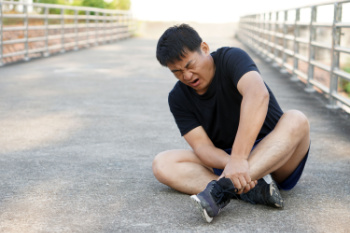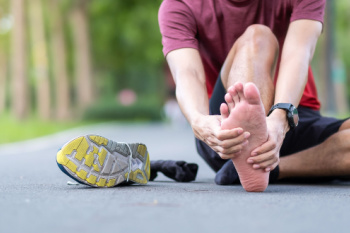Connect With Us
Blog
Items filtered by date: June 2024
Preventing Running Injuries
 Running is often considered a contact sport due to the repeated impact of the feet striking the ground. To avoid injuries while running, it is important to follow some key tips. Begin with a proper warm-up to prepare your muscles and joints for the activity ahead. Running at an easy pace most of the time allows your body to adapt to the stresses of running, reducing the risk of overuse injuries. Gradually increasing your running intensity and distance helps to build endurance and strength safely. Incorporate strength training exercises to enhance muscle stability and support your joints. Pay attention to your running form, maintaining an upright posture and a mid-foot strike to distribute impact forces evenly. Wearing appropriate, well-fitted running shoes is essential to provide the necessary support and cushioning. Lastly, listen to your body, and rest if you feel pain or discomfort. If you are a runner, to get the most out of your sport, it is suggested that you seek personalized advice and injury prevention strategies from a podiatrist.
Running is often considered a contact sport due to the repeated impact of the feet striking the ground. To avoid injuries while running, it is important to follow some key tips. Begin with a proper warm-up to prepare your muscles and joints for the activity ahead. Running at an easy pace most of the time allows your body to adapt to the stresses of running, reducing the risk of overuse injuries. Gradually increasing your running intensity and distance helps to build endurance and strength safely. Incorporate strength training exercises to enhance muscle stability and support your joints. Pay attention to your running form, maintaining an upright posture and a mid-foot strike to distribute impact forces evenly. Wearing appropriate, well-fitted running shoes is essential to provide the necessary support and cushioning. Lastly, listen to your body, and rest if you feel pain or discomfort. If you are a runner, to get the most out of your sport, it is suggested that you seek personalized advice and injury prevention strategies from a podiatrist.
All runners should take extra precaution when trying to avoid injury. If you have any concerns about your feet, contact one of our podiatrists of Boca Raton Podiatry . Our doctors will treat your foot and ankle needs.
How to Prevent Running Injuries
There are a lot of mistakes a runner can make prior to a workout that can induce injury. A lot of athletes tend to overstretch before running, instead of saving those workouts for a post-run routine. Deep lunges and hand-to-toe hamstring pulls should be performed after a workout instead of during a warmup. Another common mistake is jumping into an intense routine before your body is physically prepared for it. You should try to ease your way into long-distance running instead of forcing yourself to rush into it.
More Tips for Preventing Injury
- Incorporate Strength Training into Workouts - This will help improve the body’s overall athleticism
- Improve and Maintain Your Flexibility – Stretching everyday will help improve overall performance
- “Warm Up” Before Running and “Cool Down” Afterward – A warm up of 5-10 minutes helps get rid of lactic acid in the muscles and prevents delayed muscle soreness
- Cross-Training is Crucial
- Wear Proper Running Shoes
- Have a Formal Gait Analysis – Poor biomechanics can easily cause injury
If you have any questions, please feel free to contact our office located in Boca Raton, FL . We offer the newest diagnostic and treatment technologies for all your foot care needs.
Gout Pain Can Be Managed
Ankle Pain Can Interfere With Walking
 Ankle pain while walking is a common issue that can arise from various conditions and injuries. This can be difficult just with regular movement, but particularly frustrating when you count walking as an important form of exercise in your life. The ankle is a complex joint connecting the foot to the leg, consisting of bones, ligaments, tendons, and muscles. Pain can result from sprains, strains, fractures, or conditions such as arthritis, tendinitis, and bursitis. Overuse, wearing improper footwear, and sudden changes in physical activity can also contribute to ankle pain. This pain can interfere with walking by causing discomfort, instability, and limited range of motion. Ankle pain may present as a sharp, stabbing sensation or a dull ache, often worsening with weight-bearing activities. Swelling, bruising, and stiffness are common symptoms accompanying the pain. To alleviate ankle pain, rest, compression, and elevation are effective initial treatments. Pain relievers and wearing supportive footwear can also help. Preventative measures include strengthening and stretching exercises, wearing appropriate shoes, and gradually increasing activity levels. If you have persistent or severe ankle pain, it is suggested that you schedule an appointment with a podiatrist for a proper diagnosis and treatment plan so you can walk comfortably again.
Ankle pain while walking is a common issue that can arise from various conditions and injuries. This can be difficult just with regular movement, but particularly frustrating when you count walking as an important form of exercise in your life. The ankle is a complex joint connecting the foot to the leg, consisting of bones, ligaments, tendons, and muscles. Pain can result from sprains, strains, fractures, or conditions such as arthritis, tendinitis, and bursitis. Overuse, wearing improper footwear, and sudden changes in physical activity can also contribute to ankle pain. This pain can interfere with walking by causing discomfort, instability, and limited range of motion. Ankle pain may present as a sharp, stabbing sensation or a dull ache, often worsening with weight-bearing activities. Swelling, bruising, and stiffness are common symptoms accompanying the pain. To alleviate ankle pain, rest, compression, and elevation are effective initial treatments. Pain relievers and wearing supportive footwear can also help. Preventative measures include strengthening and stretching exercises, wearing appropriate shoes, and gradually increasing activity levels. If you have persistent or severe ankle pain, it is suggested that you schedule an appointment with a podiatrist for a proper diagnosis and treatment plan so you can walk comfortably again.
Ankle and foot injuries are common among athletes and in many sports. They can be caused by several problems and may be potentially serious. If you are feeling pain or think you were injured in a sporting event or when exercising, consult with one of our podiatrists from Boca Raton Podiatry . Our doctors will assess your condition and provide you with quality foot and ankle treatment.
Common Injuries
The most common injuries that occur in sporting activities include:
- Achilles Tendonitis
- Achilles Tendon Rupture
- Ankle Sprains
- Broken Foot
- Plantar Fasciitis
- Stress Fractures
- Turf Toe
Symptoms
Symptoms vary depending upon the injury and in some cases, there may be no symptoms at all. However, in most cases, some form of symptom is experienced. Pain, aching, burning, bruising, tenderness, tightness or stiffness, sensation loss, difficulty moving, and swelling are the most common symptoms.
Treatment
Just as symptoms vary depending upon the injury, so do treatment options. A common treatment method is known as the RICE method. This method involves rest, applying ice, compression and elevating the afflicted foot or ankle. If the injury appears to be more serious, surgery might be required, such as arthroscopic or reconstructive surgery. Lastly, rehabilitation or therapy might be needed to gain full functionality in the afflicted area. Any discomfort experienced by an athlete must be evaluated by a licensed, reputable medical professional.
If you have any questions, please feel free to contact our office located in Boca Raton, FL . We offer the newest diagnostic and treatment technologies for all your foot care needs.
Fall Prevention Tips for Babies and Children

As babies and children explore their surroundings, falls are an inevitable part of their journey to independence. However, implementing precautionary measures can significantly reduce the risk of accidents and injuries. Start by creating a safe environment with secured gates at staircases and window guards to prevent falls from elevated surfaces. Ensure furniture is anchored to the wall to prevent tipping and keep floors clutter-free to minimize tripping hazards. When it comes to infants, always supervise them during diaper changes and avoid leaving them unattended on elevated surfaces such as changing tables or sofas. For toddlers and older children, teach them the importance of using handrails when climbing stairs and encourage safe play practices, such as not running indoors or jumping from high places. Additionally, provide age-appropriate toys and equipment and supervise them during activities such as climbing, swinging, or riding bikes. Many children’s feet can be affected from falling, which can hinder enjoying daily activities. If your child has fallen and has foot pain, it is suggested that you consult a podiatrist who can offer treatment solutions, and guide you on more effective fall prevention techniques for your children.
Preventing falls among the elderly is very important. If you are older and have fallen or fear that you are prone to falling, consult with one of our podiatrists from Boca Raton Podiatry . Our doctors will assess your condition and provide you with quality advice and care.
Every 11 seconds, an elderly American is being treated in an emergency room for a fall related injury. Falls are the leading cause of head and hip injuries for those 65 and older. Due to decreases in strength, balance, senses, and lack of awareness, elderly persons are very susceptible to falling. Thankfully, there are a number of things older persons can do to prevent falls.
How to Prevent Falls
Some effective methods that older persons can do to prevent falls include:
- Enrolling in strength and balance exercise program to increase balance and strength
- Periodically having your sight and hearing checked
- Discuss any medications you have with a doctor to see if it increases the risk of falling
- Clearing the house of falling hazards and installing devices like grab bars and railings
- Utilizing a walker or cane
- Wearing shoes that provide good support and cushioning
- Talking to family members about falling and increasing awareness
Falling can be a traumatic and embarrassing experience for elderly persons; this can make them less willing to leave the house, and less willing to talk to someone about their fears of falling. Doing such things, however, will increase the likelihood of tripping or losing one’s balance. Knowing the causes of falling and how to prevent them is the best way to mitigate the risk of serious injury.
If you have any questions, please feel free to contact our office located in Boca Raton, FL . We offer the newest diagnostic and treatment technologies for all your foot care needs.
Causes and Symptoms of Plantar Fasciitis

If you have ever felt a stabbing pain in your heel, especially when you first step out of bed in the morning, you might be experiencing plantar fasciitis. This condition, often referred to as painful heel syndrome or runner's heel, occurs when the plantar fascia, or tissue, that connects your heel bone to your toes becomes inflamed or tight. This causes intense discomfort, especially after periods of rest. Although plantar fasciitis is considered a repetitive stress injury, not just athletes are at risk. Anyone who spends a lot of time on their feet or has recently changed their exercise routine may develop plantar fasciitis. The pain is typically gradual, worsening throughout the day, and affects your ability to walk. It may even radiate toward your toes. While weight gain and sudden increases in activity can contribute to plantar fasciitis, it is essential to consult a podiatrist for proper diagnosis and treatment as other factors may be involved. A podiatrist is trained to assess this condition and recommend personalized treatment options, including stretching exercises, orthotic shoe inserts, or pain relief medication. Ignoring the symptoms of plantar fasciitis can lead to chronic heel pain or changes in your gait that may affect other parts of your body. For help in managing plantar fasciitis, it is suggested that you schedule an appointment with a podiatrist.
Plantar fasciitis can be very painful and inconvenient. If you are experiencing heel pain or symptoms of plantar fasciitis, contact one of our podiatrists from Boca Raton Podiatry . Our doctors can provide the care you need to keep you pain-free and on your feet.
What Is Plantar Fasciitis?
Plantar fasciitis is the inflammation of the thick band of tissue that runs along the bottom of your foot, known as the plantar fascia, and causes mild to severe heel pain.
What Causes Plantar Fasciitis?
- Excessive running
- Non-supportive shoes
- Overpronation
- Repeated stretching and tearing of the plantar fascia
How Can It Be Treated?
- Conservative measures – anti-inflammatories, ice packs, stretching exercises, physical therapy, orthotic devices
- Shockwave therapy – sound waves are sent to the affected area to facilitate healing and are usually used for chronic cases of plantar fasciitis
- Surgery – usually only used as a last resort when all else fails. The plantar fascia can be surgically detached from the heel
While very treatable, plantar fasciitis is definitely not something that should be ignored. Especially in severe cases, speaking to your doctor right away is highly recommended to avoid complications and severe heel pain. Your podiatrist can work with you to provide the appropriate treatment options tailored to your condition.
If you have any questions please feel free to contact our office located in Boca Raton, FL . We offer the newest diagnostic and treatment technologies for all your foot and ankle needs.

